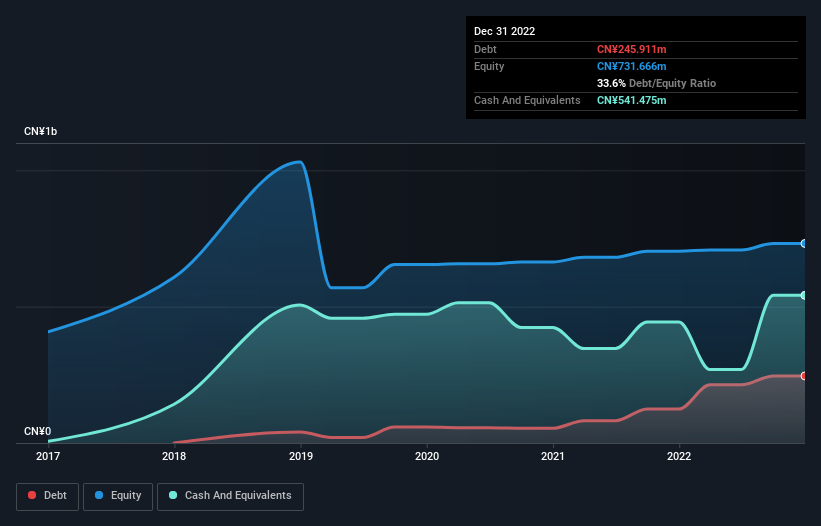- Hong Kong
- /
- Construction
- /
- SEHK:2258
Watts International Maritime (HKG:2258) Use Of Debt Could Be Considered Risky

Some say volatility, rather than debt, is the best way to think about risk as an investor, but Warren Buffett famously said that 'Volatility is far from synonymous with risk.' So it might be obvious that you need to consider debt, when you think about how risky any given stock is, because too much debt can sink a company. As with many other companies Watts International Maritime Company Limited (HKG:2258) makes use of debt. But the more important question is: how much risk is that debt creating?
Why Does Debt Bring Risk?
Generally speaking, debt only becomes a real problem when a company can't easily pay it off, either by raising capital or with its own cash flow. Part and parcel of capitalism is the process of 'creative destruction' where failed businesses are mercilessly liquidated by their bankers. While that is not too common, we often do see indebted companies permanently diluting shareholders because lenders force them to raise capital at a distressed price. Of course, debt can be an important tool in businesses, particularly capital heavy businesses. The first step when considering a company's debt levels is to consider its cash and debt together.
View our latest analysis for Watts International Maritime
How Much Debt Does Watts International Maritime Carry?
The image below, which you can click on for greater detail, shows that at December 2022 Watts International Maritime had debt of CN¥245.9m, up from CN¥124.4m in one year. But it also has CN¥541.5m in cash to offset that, meaning it has CN¥295.6m net cash.

A Look At Watts International Maritime's Liabilities
The latest balance sheet data shows that Watts International Maritime had liabilities of CN¥2.48b due within a year, and liabilities of CN¥233.9m falling due after that. Offsetting this, it had CN¥541.5m in cash and CN¥1.81b in receivables that were due within 12 months. So its liabilities outweigh the sum of its cash and (near-term) receivables by CN¥359.0m.
The deficiency here weighs heavily on the CN¥200.1m company itself, as if a child were struggling under the weight of an enormous back-pack full of books, his sports gear, and a trumpet. So we definitely think shareholders need to watch this one closely. After all, Watts International Maritime would likely require a major re-capitalisation if it had to pay its creditors today. Given that Watts International Maritime has more cash than debt, we're pretty confident it can handle its debt, despite the fact that it has a lot of liabilities in total.
In fact Watts International Maritime's saving grace is its low debt levels, because its EBIT has tanked 37% in the last twelve months. When a company sees its earnings tank, it can sometimes find its relationships with its lenders turn sour. There's no doubt that we learn most about debt from the balance sheet. But you can't view debt in total isolation; since Watts International Maritime will need earnings to service that debt. So when considering debt, it's definitely worth looking at the earnings trend. Click here for an interactive snapshot.
But our final consideration is also important, because a company cannot pay debt with paper profits; it needs cold hard cash. Watts International Maritime may have net cash on the balance sheet, but it is still interesting to look at how well the business converts its earnings before interest and tax (EBIT) to free cash flow, because that will influence both its need for, and its capacity to manage debt. Over the last three years, Watts International Maritime reported free cash flow worth 3.9% of its EBIT, which is really quite low. For us, cash conversion that low sparks a little paranoia about is ability to extinguish debt.
Summing Up
While Watts International Maritime does have more liabilities than liquid assets, it also has net cash of CN¥295.6m. However, we do find both Watts International Maritime's level of total liabilities and its EBIT growth rate troubling. So even though it has net cash, we do think the business has some risks worth watching. When analysing debt levels, the balance sheet is the obvious place to start. However, not all investment risk resides within the balance sheet - far from it. For example Watts International Maritime has 4 warning signs (and 1 which shouldn't be ignored) we think you should know about.
At the end of the day, it's often better to focus on companies that are free from net debt. You can access our special list of such companies (all with a track record of profit growth). It's free.
Valuation is complex, but we're here to simplify it.
Discover if Watts International Maritime might be undervalued or overvalued with our detailed analysis, featuring fair value estimates, potential risks, dividends, insider trades, and its financial condition.
Access Free AnalysisHave feedback on this article? Concerned about the content? Get in touch with us directly. Alternatively, email editorial-team (at) simplywallst.com.
This article by Simply Wall St is general in nature. We provide commentary based on historical data and analyst forecasts only using an unbiased methodology and our articles are not intended to be financial advice. It does not constitute a recommendation to buy or sell any stock, and does not take account of your objectives, or your financial situation. We aim to bring you long-term focused analysis driven by fundamental data. Note that our analysis may not factor in the latest price-sensitive company announcements or qualitative material. Simply Wall St has no position in any stocks mentioned.
About SEHK:2258
Watts International Maritime
An investment holding company, operates as a port, waterway, and marine and municipal public engineering services provider in the People's Republic of China.
Mediocre balance sheet and slightly overvalued.
Market Insights
Community Narratives




